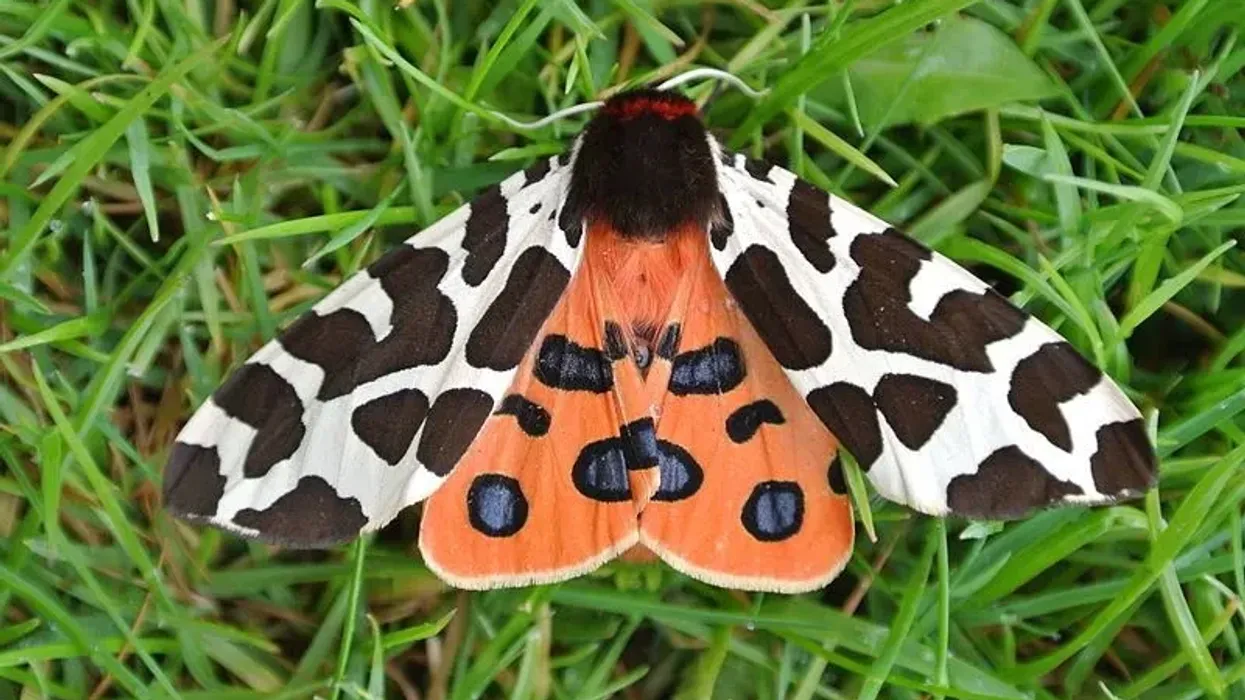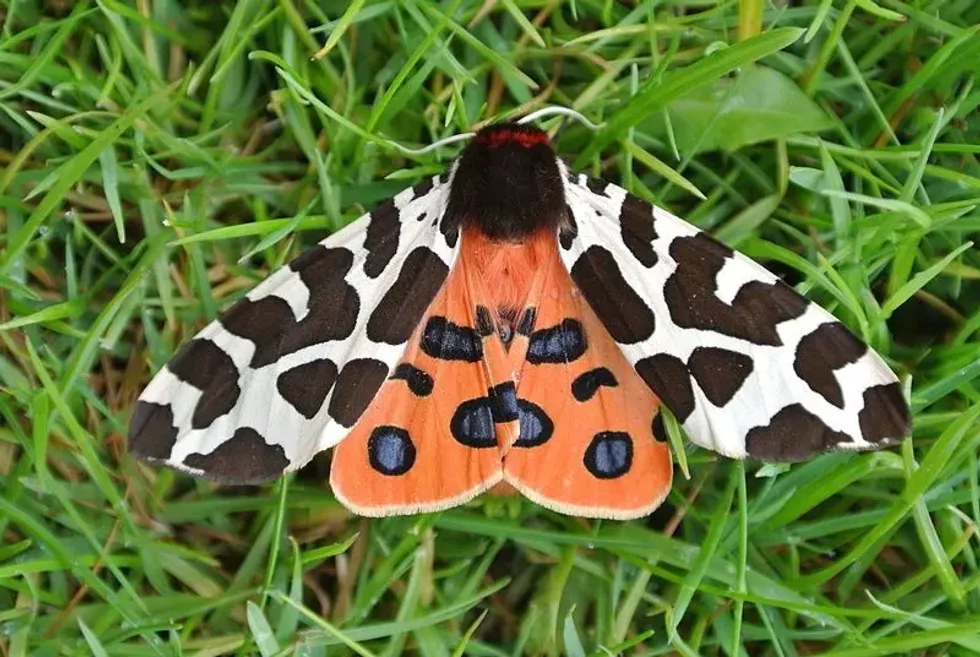The garden tiger moth is a rapidly declining priority species found throughout Europe, North America, and Canada. They dwell in cold temperatures and open spaces like meadows, amongst sand dunes, amidst garden plants and river banks.
They have a striking brown and white pattern on their bodies which makes them instantly recognizable. Like all moths, their life begins as an egg that hatches into a caterpillar.
Caterpillars are also extremely distinct as they are completely black and covered in long dark hair, because of which they are called "woolly bears." They are nocturnal and mostly feed on nectar and other smaller garden plants.
During their caterpillar stage, they feed on a variety of toxic leaves, which are easily digested by their evolved digestive system. Moreover, many fluids in their body are harmful to animals, and the bright coloration is a warning to birds and other predators.
Their cervix also contains patterned red hair, which symbolizes toxicity. Their fluids contain neurotoxins which can affect the working of an animal's acetylcholine receptor. Therefore, they present themself as inedible and human activity poses a greater threat to them than the predators.
If the garden tiger moth interests you, then check out these gypsy moth facts and Luna moth facts.
Garden Tiger Moth Interesting Facts
What type of animal is a garden tiger moth?
The garden tiger moth is an insect.
What class of animal does a garden tiger moth belong to?
The garden tiger moth belongs to the class of Insecta.
How many garden tiger moths are there in the world?
There is no specific estimate regarding the total number of garden tiger moths in the world. However, their population in the UK alone has decreased by around 89% in the last 30 years.
Where does a garden tiger moth live?
This species is found in Europe, the northern US, and Canada. Their range also extends from North to Central Asia.
What is a garden tiger moth's habitat?
The garden tiger moth habitat includes open green spaces like city gardens, along with the plants on river banks, amongst sand dunes with some plant cover, and open meadows. They are also found in forests. Unlike some insects, they do not generally live in places with their host plants. Rather, they are climate dependent and prefer cooler spots.
Who do garden tiger moths live with?
As caterpillars, they remain together to ward off predators. However, moths are solitary creatures and live alone. They only seek out a mate during the breeding season.
How long does a garden tiger moth live?
The garden tiger moth's life cycle is extremely short. After hatching from eggs, the caterpillar feeds for a few months and then retires to spin a garden tiger moth pupa. The caterpillars remain in the cocoon for one to three weeks and emerge as moths. Adults live for one to two weeks where they look for mates.
How do they reproduce?
Adults are active from June to September. During this time, they find a mate and engage in reproduction.
The female will lay eggs on the underside of a leaf in gardens or the wild. The eggs will hatch in a few days, usually between August to September.
Young caterpillars feed voraciously on the smaller plants, dock leaves, nettles, and more. They have a wide body covered with long, dark hair. Caterpillars forage on the ground instead of climbing onto a host plant.
After feeding for a few months, the caterpillars look for a dry space among leaf litter or lower plant boughs and spin a pupa. However, sometimes the caterpillar pupa houses the larvae for the entire winter.
The garden tiger moth cocoon is made from their larval hair and silk that they spin. After emerging from the pupa, the moths mainly feed on nectar and die within 10 days after laying eggs again.
What is their conservation status?
The population of the Tiger Moth Arctia caja is rapidly declining due to the overuse of pesticides while growing plants, habitat loss, and general pollution. They have been protected under the Biodiversity Action Plan (BAP) in the UK since 2007. They are a priority species and can only be captured for research purposes by affiliated laboratories.
Garden Tiger Moth Fun Facts
What do garden tiger moths look like?
The garden tiger moth has a furry black body with bright wings and a small head. When resting their hind wings, having red and black dots, go under their front wings, which have brown and white patterns.
They have two furry antennas on their head. As caterpillars, they have six legs with many dummy legs that act as a suction to help them climb plants or travel on dock leaves. The caterpillar form is long and fully black with long hairs that turn brown at the ends.
How cute are they?
In both caterpillar and moth form, the garden tiger moth is extremely cute! They look very fuzzy and round, with hairs covering their body. As moths, their color patterns make them extremely appealing. However, the scales can cause irritation and allergic reactions in humans and animals, so one should not touch them.
How do they communicate?
The adult communicates by scraping their wings together to emit a rasping sound. They can also emit high-pitched squeaks, which are audible to human ears. The squeak is also audible to bats who avoid such toxic moths.
How big is a garden tiger moth?
The wingspan of the tiger moth is 1.8-2.6 in (45.7-66mm). It is almost half the size of one-eyed sphinx moths and almost twice the size of the bee hummingbird, the smallest of the hummingbird species.
How fast can garden tiger moths fly?
There is no specific data to verify the speed; however, as they are moths, it's safe to say that they're not the fastest creatures.
How much does a garden tiger moth weigh?
The exact weight is not known; it can be said they do not weigh more than a few grams.
What are the male and female names of their species?
Both males and females of the species are known as moths.
What would you call a baby garden tiger moth?
The baby is called a garden tiger moth larva which eventually becomes a caterpillar.
What do they eat?
In caterpillar form, they eat many types of plants like foxgloves, plantain, dock leaves, and various toxic plants, which give these garden tigers their toxicity. Adults drink nectar.
Are they dangerous?
The poisonous fluid emitted by adult moths when threatened can be toxic to humans. Many people might also be allergic to the wing scales and hairs on caterpillars. However, if one is not allergic to garden tiger moth caterpillar fur, then carrying the young one is safe.
Would they make a good pet?
In the UK, they are protected species and cannot be kept as pets. Besides, keeping toxic animals as pets is not encouraged as both their hairs and fluids can cause adverse reactions.
If one does find an abandoned tiger moth caterpillar out in the cold, it is best to leave it alone if it is not hurt. They are equipped to deal with an extremely cold climate, so one must not interfere with their natural cycle.
Did you know...
The Asota caricae, a species of tiger moth found in Kerala, India, caused an epidemic. This was because of the mixing of their scales and hairs with air forming aerosols and causing allergic reactions. People generally suffered from high fever, and because the diagnosis of the problem took time (misleading symptoms), a few people lost their lives.
What states have the garden tiger moth been found in?
They are found in the northern states of the US, Scotland, UK, Central Asia, and the colder parts of Europe up to the Laplands.
How to care for a garden tiger moth caterpillar?
Garden tiger moth caterpillar care is quite similar to that for other woolly caterpillars. It is best to keep them in an enclosed space with breathing holes for better care. The bottom should contain a slightly damp paper towel.
Their food plant should be replenished daily and droppings cleared. Synthetic food is also available in the market, which is made from a mix of cellulose, sucrose, cabbage, and other items.
During winter, adding mulch or dead leaves helps the caterpillar to sleep underneath it. After it forms its cocoon, add sticks so that the emerging moth can dry itself. Release them after two days.
Here at Kidadl, we have carefully created lots of interesting family-friendly animal facts for everyone to discover! For more relatable content, check out these plume moth facts and puss moth facts pages.
You can even occupy yourself at home by coloring in one of our free printable garden tiger moth coloring pages.









